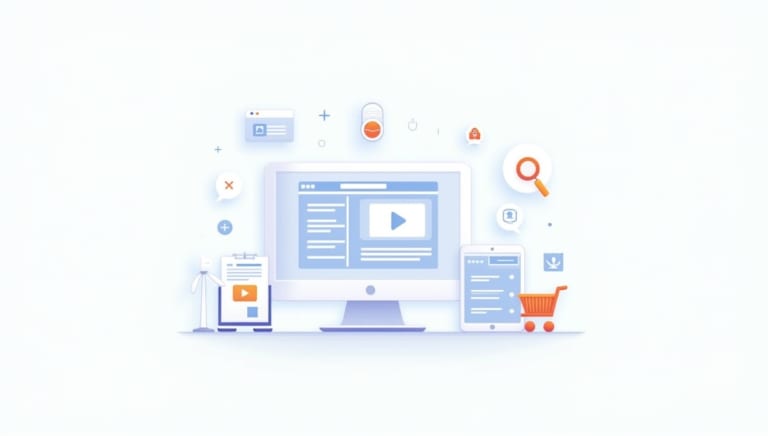Blog Categories
- Custom Web Development Solutions
- E-Commerce Website Design and Development
- Future of Website Design and Development
- Mobile-First and Responsive Design
- Outsourcing Benefits and Challenges
- SEO and Website Performance Optimization
- Technologies for Website Development
- Web Design for Startups
- Web Design Trends
- Website Development Best Practices
Tags
Services we Offer
Top UX Design Tips for E-Commerce Websites in 2025
February 13, 2025

The e-commerce landscape is evolving at breakneck speed. By 2025, global online sales are projected to surpass $7.4 trillion, but competition will be fiercer than ever. To stand out, businesses must prioritize user experience (UX)—blending innovation, empathy, and technology to create seamless, memorable shopping journeys.
This blog unpacks the top UX design strategies poised to dominate e-commerce in 2025, backed by real-world examples and insights from OOPS INFOTECH, a leading web design and development agency in India.
Why UX Design is the Backbone of E-Commerce Success
A 2024 Baymard Institute study revealed that 88% of online shoppers won’t return to a site after a poor user experience. With rising consumer expectations, UX design directly impacts:
- Conversion Rates: Intuitive navigation reduces cart abandonment.
- Brand Loyalty: Personalized experiences foster emotional connections.
- SEO Performance: Google’s Core Web Vitals prioritize UX metrics like load speed and interactivity.
In 2025, UX will transcend aesthetics—integrating AI, sustainability, and immersive tech to meet shoppers’ evolving needs.
Top 10 UX Design Tips for E-Commerce in 2025
1. Hyper-Personalization with AI
Why It Matters: Shoppers expect tailored experiences. AI analyzes behavior, preferences, and purchase history to deliver dynamic content.
- Implementation:
- Use machine learning to recommend products (e.g., “Customers like you also bought…”).
- Customize homepage layouts based on user demographics.
- Deploy AI chatbots for real-time, context-aware support.
OOPS INFOTECH Case Study: A beauty retailer saw a 35% increase in average order value after integrating AI-driven skincare quizzes.
2. Voice Commerce Optimization
Why It Matters: Voice shopping is projected to hit $19.4 billion by 2025 (Juniper Research). Users seek hands-free, conversational interfaces.
- Implementation:
- Optimize for voice search with natural-language keywords (e.g., “Where can I buy organic cotton shirts?”).
- Enable voice-guided navigation and checkout.
- Support multilingual voice assistants.
3. Immersive AR/VR Shopping
Why It Matters: Augmented Reality (AR) bridges the gap between online and in-store experiences.
- Implementation:
- Offer AR “try-on” features for apparel, eyewear, or cosmetics.
- Use 3D product previews to showcase intricate details.
- Create virtual showrooms for high-ticket items like furniture.
Example: OOPS INFOTECH developed an AR app for a jewelry brand, boosting conversions by 50% through virtual try-ons.
4. Sustainable UX Design
Why It Matters: Eco-conscious shoppers favor brands that align with their values.
- Implementation:
- Add carbon footprint calculators at checkout.
- Highlight sustainable products with badges or filters.
- Optimize images and code to reduce energy consumption.
5. Frictionless Mobile-First Experiences
Why It Matters: Mobile accounts for 73% of e-commerce sales (Statista, 2024).
- Implementation:
- Adopt “thumb-friendly” navigation with bottom menus.
- Simplify checkout with digital wallets (Apple Pay, Google Pay).
- Compress images without sacrificing quality.
6. Predictive Search & Navigation
Why It Matters: Speed is non-negotiable. Users expect instant results.
- Implementation:
- Auto-suggest search terms as users type.
- Use visual search (e.g., upload a photo to find similar products).
- Implement filters that adapt to search context.
7. Emotional Design Through Micro-Interactions
Why It Matters: Micro-interactions (e.g., button animations, hover effects) delight users and reinforce brand personality.
- Implementation:
- Celebrate purchases with playful confetti animations.
- Use progress bars during checkout to reduce anxiety.
- Add hover effects that reveal product details.
8. Inclusive & Accessible Design
Why It Matters: 16% of the global population has a disability (WHO). Accessibility is both ethical and profitable.
- Implementation:
- Ensure WCAG 2.2 compliance (e.g., alt text, keyboard navigation).
- Offer adjustable font sizes and high-contrast modes.
- Provide video captions and transcripts.
OOPS INFOTECH’s Approach: Their accessibility audits have helped clients achieve 30% wider audience reach.
9. Seamless Cross-Platform Continuity
Why It Matters: Shoppers switch between devices; UX must remain consistent.
- Implementation:
- Sync carts and wishlists across devices via cloud storage.
- Use QR codes to bridge physical and digital experiences.
- Ensure responsive design adapts to all screen sizes.
10. Proactive Security & Trust Signals
Why It Matters: 61% of users abandon purchases over security concerns (PwC).
- Implementation:
- Display trust badges (SSL, GDPR compliance).
- Explain data usage in simple terms.
- Offer guest checkout options.
Challenges in Implementing 2025 UX Trends
1. Balancing Innovation and Performance
Solution: Use lazy loading for heavy media and optimize code with tools like Lighthouse.
2. Data Privacy Concerns
Solution: Anonymize user data and comply with regional regulations (e.g., GDPR, CCPA).
3. High Development Costs
Solution: Partner with cost-effective agencies like OOPS INFOTECH for scalable solutions.
How OOPS INFOTECH Delivers Future-Ready E-Commerce UX
With a decade of experience, OOPS INFOTECH combines technical prowess with consumer psychology:
- AI/AR Integration: Custom tools for personalized, immersive shopping.
- Performance Optimization: Websites scoring 90+ on Core Web Vitals.
- Global Compliance: Secure, accessible platforms adhering to international standards.
Client Success: A European fashion brand achieved a 40% reduction in bounce rate post-OOPS INFOTECH redesign.
Conclusion
In 2025, e-commerce UX will hinge on empathy, innovation, and responsibility. By embracing AI, AR, sustainability, and inclusivity, brands can craft experiences that resonate deeply with users—turning casual browsers into loyal advocates.
Get in Touch
Ready to future-proof your e-commerce platform? Partner with OOPS INFOTECH to transform these trends into tangible results. Contact OOPS INFOTECH to start your UX evolution today.

Latest from our Blog
For resource-constrained startups, juggling every operational detail can derail growth. This article explores five ways…
Downtime can erode user trust and revenue in an instant. This comprehensive guide from OOPS…
In today’s competitive startup landscape, having a compelling online presence is non-negotiable. But for bootstrapped…
From high-speed APIs to full-featured e-commerce sites, Python powers every tier of modern web development.…







Leave a Reply